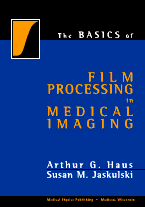
Basics of Film Processing in Medical Imaging
Author: Arthur Haus & Susan JaskulskiISBN: 9780944838785
Published: 1997 | 338 pp |
OUT OF PRINT
Table of Contents
Table of ContentsChapter 1: Film
- History
- Film Emulsion Characteristics (Single- and Double-Emulsion Films, Silver Halide Emulsions, Gelatin, Types of Grains, Overcoat, Color Sensitivity, Film Sensitivity, Modifying Film Contrast)
- Latent Image Formation and Amplification
- Storage (Storage of Unprocessed/Unexposed Film, Storage of Processed Film)
Chapter 2--Chemicals
- History
- Developer Components (Developing Agents, Buffering Agents, Preservatives, Restrainers, Hardeners, Solvents, Sequestering Agents)
- Developer Considerations (Developer/Film Interactions, Developers and Replenishment)
- Fixer Components (Fixing Agent, Preservative Agent, Hardener, Buffer, Sequestering Agents)
- Fixer Considerations (Clearing, Silver Recovery/Reuse, Odor, Drying, Buffer Capacity)
- Mixing (General Steps of Mixing, Automixers)
- Monitoring Chemicals (pH Measurement, Specific Gravity Measurement, Laboratory Analysis of Components, Processor QC)
- Chemical Storage
- Fresh and Seasoned Chemicals (Starter)
- Replenishment (Replenishment Rate Guidelines, Defining Replenishment Rates, Flooded Replenishment, Replenishment Reduction)
- Use of Recommended Chemicals
- Medical Device Regulations
- Health, Safety, and Environmental Issues (Hazard Communication, Self-Assessment Checklist for Hazard Communication, Personal Protective Equipment, Self-Assessment Checklist, Air Quality, The Regulation of Silver and Other Wastes in Medical Imaging Facilities, Using the Code of Management Practice to Manage Silver, The Technology of Silver Recovery, Off-Site Silver Recovery)
Chapter 3: Processors
- History
- Introduction to Processing
- Developing (Developer System Components)
- Fixing (Fixer System Components)
- Washing (Wash System Components)
- Drying (Dryer System Components)
- Transport System
- Replenishment System
- Film Processing Area Layout Considerations (Determining the Requirements of the Area, Evaluating the Current Area, Defining the Redesign Needs, Obtaining Equipment Information, Developing a Conceptual Plan, Reviewing Plans with the Architect, Typical Layouts)
- Processor Installation (Room Layout, Recommended Service Clearances, Dryer Exhaust, Processor Ventilation, Darkroom Ventilation and Air Exchanges, Environmental Conditions, Replenishment Lines, Sink)
- Service Requirements (Electrical, Water, Drain, Room Ambient Temperatures and Relative Humidity)
- Processing Cycle Time
- Solution Temperatures (Developer Temperature, Fixer Temperature, Water Temperature, General Thermometer Information)
- Preventive Maintenance and Cleaning (Daily Maintenance and Cleaning Procedures, Weekly, Monthly, and Periodic Maintenance and Cleaning Procedures, Startup Procedure shutdown Procedure)
Chapter 4: Image Quality
- Background
- Exposure and Density
- The Characteristic Curve
- Film Speed
- Radiographic Contrast
- Latitude
- Image Blur (Unsharpness)
- Radiographic Noise (Radiographic Mottle, Quantum Mottle)
- Artifacts
- Viewing Conditions
Chapter 5: Quality Control
- Background
- Processor QC (Tools Required for Processor QC, Using the Thermometer, Using a Simulated Light Sensitomer, Quality Control Film, Using the Densitometer, Using Processor Control Charts) and (Prior to Establishing a Processor QC Program, Establishment of a Processor QC Program, Daily Processor QC, Evaluating the Processor QC Chart, The Crossover Procedure, Reestablishing the Processor QC Program, Average Gradient)
- Fixer Retention Test (Tools Required for the Fixer Retention Test, Performing the Fixer Retention Test)
Chapter 6: Artifacts
- Artifacts on Single-Emulsion Film
- Tools for Artifact Analysis (Determining the Origin of Artifacts, General Rules for Processing Artifact Analysis, General Rules for Handling Artifact Analysis, General Rules for Equipment Artifact Analysis, Categories of Processing Artifacts, Artifact Spacing)
- Minimizing Artifacts
- Examining Films for Artifacts (Impact of Lighting Conditions, Magnification)
- Processing Artifacts (Parallel to Film Travel Artifacts, Perpendicular to Film Travel Artifacts, Randomly Occurring Artifacts)
- Shadow Images
- Isolating Individual Processor Components (Isolating the Entrance Detector Crossover Assembly, Isolating the Developer-to-Fix Crossover Assembly, Isolating the Fix-to-Wash Crossover Assembly, Isolating the Squeegee Roller Assembly and the Dryer Assembly)
Chapter 7--Troubleshooting
Appendix A: Reciprocity Law Failure and Latent Image Fading
Appendix B: Manual Method of Time-Temperature Processing
Appendix C: Handling and Processing of Mammography Film
Appendix D: The Mammographic Darkroom
Appendix E: Cleaning Intensifying Screens
Appendix F: Mobile Van Film Processing
Appendix G: The Sensitometric Technique for the Evaluation of Processing
(STEP) Test
Glossary


